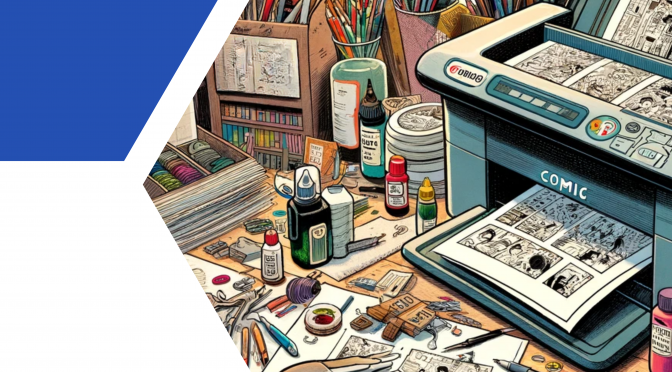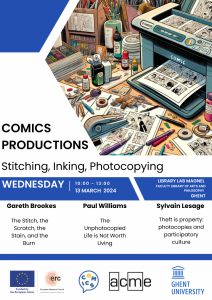Comics Productions: Stitching, Inking, Photocopying
13 March 2024, 10:00 am-1:00 pm, Library Lab Magnel, Ghent University, Faculty Library of Arts and Philosophy
The Stitch, the Scratch, the Stain, and the Burn – the mechanically reproduced comics page as a site of embodied encounter with material indexes.
Gareth Brookes
Reproduction technology has always framed the ways in which we encounter and experience comics. Bart Beaty has described European small press as an ongoing attempt to reinscribe the aura of the work of art into the mechanically reproduced object. As such, small press practice can be theorised as a set of continuously adapting inscription strategies responding to new technologies.
The widespread availability of photographic scanning and digital printing represent examples of methods which have enabled the translation and manipulation of the indexical trace of materials and bodies onto the surface of the comics page. Theories of haptics and embodiment help to describe ways in which surfaces of depiction can throw the reader’s attention back on their own bodies. The experience of reading comics can therefore be framed in terms of navigating sites of embodied encounter, producing readings which go beyond the iconic and textual and activating other senses, most significantly that of touch.
The use of photoshop and procreate, alongside the rising popularity of reading on screens, has further altered the relationship between the reading body and the drawn trace. Meanwhile, in handmade examples of small press, the index of the body in the making of the comic object, co-exists with the embodied trace inscribed in the surface of reproduction, producing multiple registers of embodied meaning.
Through a discussion of a range of comics alongside examples from my own practice, I aim to show that the analysis of comics can be updated to account for the reader’s embodied experience of mechanically and digitally reproduced haptic surfaces. I will argue that ways in which comics creators use materials and styles of mark making to facilitate embodied reading should be integrated into notions of comics as narrative networks.
“Theft is property”: photocopies and participatory culture
Sylvain Lesage, University of Lille
As part of a project devoted to the political and cultural impact of the photocopier in French society at the end of the twentieth century, I’m questioning the re-appropriation of photocopiers as a tool that encapsulates the contradictions of mass culture. Through its low cost and its user-friendliness, photocopiers popularize micro-publishing and participate in the advent of a do-it-yourself (DIY) culture. They amplified a culture of borrowing, copying and pasting at the heart of fanzine activity, which proposed a recirculation of commercial images and texts in the space of the underground.
This project – at its very early stages – considers the diversity of fanzine models and the modalities of fan involvement. The creativity deployed by communities of fans redistributed roles between producers and consumers. This project therefore aims to track down the beginnings of a participatory culture that took shape around – and through – photocopiers. These counter-cultural practices recirculated cultural goods, putting copyright and intellectual property to the test: in fanzine culture, “theft is property”.
The Unphotocopied Life is Not Worth Living
Paul Williams
Many scholars have underlined the artisanal matrix of minicomic creation, figuring minicomics as unique art objects by virtue of hand-glued fabric, hand-coloured colours, bespoke ink stamps, and other acts of personalization. In this paper I want to linger on how minicomics are made, which historically has been by folding, cutting, and stapling double-sided photocopied pages: to make a minicomic is a form of labour that traces the labour of office work. As such, it cannot be entirely separated from the social hierarchies, power imbalances, and affective investments of the workplace, and this paper positions the act of making a comic with a photocopier and a stapler much closer to the uneventful, frustrating warp and weft of daily employment than usually takes place in comics scholarship and adjacent fields. Which is not to reject completely the implications of the handmade thesis, but it does mean seeing the minicomic poised somewhere between the artisanal work and the mass-produced commodity.
This paper, then, airs the proposition that making a minicomic means entering into relations of (self) reproduction structured by the intended function of photocopiers and staplers as office equipment, but the affective relations we have with these machines can and does exceed their original intended functions. These relations point to utopian possibilities of expression, but they can also entrench workplace inequalities and coercion. Furthermore, once they are in the world, minicomics refuse to abide by norms of comics collecting, from retail to storage, and where the latter is concerned, minis transgress norms of heteronormative domestic display more generally. This paper links this to the games that minicomics play with personal archiving practices, refusing to sit still and stay in one place, failing to observe the archival propriety of homogeneously moving through time in a stable location and appearing punctually when bidden.

